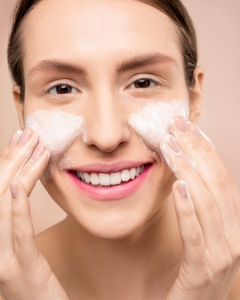Pityrosporum Folliculitis / Malassezia Folliculitis: 9 things to know
Pityrosporum Folliculitis / Malassezia Folliculitis (inflammation of the pores) is a common dermatological condition that can occur in both men and women. The disease is not only uncomfortable but also seriously affects the aesthetics of the sufferer. Understanding the causes and symptoms of the disease will help the patient soon find the most effective prevention and treatment.
- I- What is Pityrosporum Folliculitis / Malassezia Folliculitis?
- II- The most common cause of Pityrosporum Folliculitis / Malassezia Folliculitis
- III- Factors that increase your risk of Pityrosporum Folliculitis / Malassezia Folliculitis
- IV- Common and recognizable symptoms of this Pityrosporum Folliculitis / Malassezia Folliculitis include
- V- Common positions of Pityrosporum Folliculitis / Malassezia Folliculitis and image recognition
- VI- Is Pityrosporum Folliculitis / Malassezia Folliculitis contagious? What is the path of transmission?
- VII- Can Pityrosporum Folliculitis / Malassezia Folliculitis can be cured? How long is the treatment?
- VIII- How to diagnose Pityrosporum Folliculitis / Malassezia Folliculitis?
- IX- The most effective treatment for Pityrosporum Folliculitis / Malassezia Folliculitis
- 1- Curing Pityrosporum Folliculitis / Malassezia Folliculitis at home with folk tips
- 2- Treatment of Pityrosporum Folliculitis / Malassezia Folliculitis according to Western medicine
- 3- Treatment of Pityrosporum Folliculitis / Malassezia Folliculitis with surgical methods
I- What is Pityrosporum Folliculitis / Malassezia Folliculitis?
Pores cover all over the skin's surface, including hair follicles and natural oils to help the skin balance nutrients and moisture. At the same time, this part also helps regulate body temperature, excretion of substances from the inside of the body to the outside.
Pityrosporum Folliculitis / Malassezia Folliculitis is an inflammation of the pores that causes itchy, lumpy, and red swelling of the skin. The disease occurs mainly due to bacteria Staphylococcus aureus. In addition, improper shaving, wearing tight clothing, skin excreted a lot of sweat ... is also the cause of this condition.
This pathology can occur at any sex or age. Depending on the person, the symptoms of the disease will be different. Depending on the severity of the damage or the cause of the disease, Pityrosporum Folliculitis / Malassezia Folliculitis is classified into two categories:
- Shallow Pityrosporum Folliculitis / Malassezia Folliculitis: This condition involves part of the follicle, caused by the bacteria Staphylococcus aureus, the fungus Pityrosporum or the wrong use of a razor ...
- Deep Pityrosporum Folliculitis / Malassezia Folliculitis: A serious disease, involving the entire follicle, occurs due to gram-negative bacteria, inflammation in the beard (men) or eosinophilic Pityrosporum Folliculitis / Malassezia Folliculitis ...
This pathology rarely poses a danger to the health of the patient. However, the appearance of red, pus-filled, itchy, and painful spots on the skin surface makes it easy to feel uncomfortable and at the same time cause serious loss of aesthetics. Since then, the disease causes psychological fear, loss of confidence when communicating with other people.

What is Pityrosporum Folliculitis / Malassezia Folliculitis? / ph: pexels
II- The most common cause of Pityrosporum Folliculitis / Malassezia Folliculitis
This pathology is caused by many different factors. The most common causes of Pityrosporum Folliculitis / Malassezia Folliculitis are bacteria, viruses, fungi, and parasites. As follows:
- Golden Staphylococcus: This bacteria often causes Pityrosporum Folliculitis / Malassezia Folliculitis of the pores in skin areas such as nape, sideburns, beard, armpits, pubic hair, or seborrheic folliculitis.
- Microporum Pityrosporum Folliculitis / Malassezia Folliculitis (mycelium): Usually causes damage to the scalp, manifested as a round, white scaly skin patch. Therefore, it can cause hair loss, scalp scarring or increase the risk of baldness.
- Due to Malassezia: This fungus often thrives in hot and humid weather, causing Pityrosporum Folliculitis / Malassezia Folliculitis in the skin of the face, neck, back, arms.
- Due to the gram-negative bacteria: This is often caused by the patient taking antibiotics for a long time, causing a rash on the face of the face. Even if severe, it can form Pityrosporum Folliculitis / Malassezia Folliculitis abscesses in the cheeks, chin.
- Due to the herpes virus: This virus often causes Pityrosporum Folliculitis / Malassezia Folliculitis of the pores in the mustache, which is characteristic that small blisters grow concentrated, after a few days crusting and peeling off.
- Molluscum contagiosum Pityrosporum Folliculitis / Malassezia Folliculitis (Molluscum contagiosum virus): The disease occurs because this virus can go away on its own after a few months. This virus easily causes disease in the mustache, chin and beard areas. The molluscum contagiosum virus does not exist on the skin but is usually spread from others.
- Folliculitis caused by Demodex: This is a parasite that can multiply and thrive on the skin when the body is not clean.
- Eosinophilia: This factor is common in people with weakened immune systems
Exposure to chemicals, polluted and smoky environments: This causes the skin to become blocked and damaged, and at the same time create favorable conditions for pathogenic bacteria to live on the skin.
- Due to Pseudomonas bacteria: Common in hot baths with chlorine or an unbalanced pH.
III- Factors that increase your risk of Pityrosporum Folliculitis / Malassezia Folliculitis
In addition to the above causes of the disease, this dermatological pathology is more likely to occur if it meets the following favorable conditions:
- Acne-prone skin
- Wear tight, tight, material that doesn't absorb sweat
- The air has high humidity and hot weather
- The skin is sweaty, oily skin
- Use cosmetics, shower gels that contain ingredients that easily cause skin irritation
- Improper waxing, hair removal, and shaving
- Use topical and oral corticosteroids for a long time, creating favorable conditions for the growth of pathogenic bacteria.
- Skin hygiene is not clean
- Take a hot bath
- People with diabetes, obesity, kidney failure, weakened immune system, iron deficiency anemia ... also often suffer from folliculitis than healthy people.
Symptoms of folliculitis are easy to recognize
Depending on the type of disease, the cause of the disease, the symptoms of Pityrosporum Folliculitis / Malassezia Folliculitis will be different.
IV- Common and recognizable symptoms of this Pityrosporum Folliculitis / Malassezia Folliculitis include
- Red rash, small acne in hair follicles
- Bright red circles around inflamed hair follicles
- After a few days, the acne will be pus and easy to break, then dry again, scaly.
- Skin feels itchy, uncomfortable.
On some areas of the skin, pimples can grow in thick clumps, causing itching, red inflammation, painful swelling and possible scarring.
V- Common positions of Pityrosporum Folliculitis / Malassezia Folliculitis and image recognition
The inflammation of the pores can occur anywhere on the body. The most common however are the following areas of the skin:
- Pityrosporum Folliculitis / Malassezia Folliculitis of the face
This pathology causes the skin of the face to become rough, blackheads, red acne, whiteheads, itchy skin, ingrown hairs and twisted hair follicles. Without proper care and treatment, the disease can develop gradually and worsen, causing swelling, pain, infection and an abscess formation. At this time, the disease is easy to leave scars on skin.
- Pityrosporum Folliculitis / Malassezia Folliculitis in the hands
In the hand skin, pores appear pus cysts, causing itchy skin, burning pain, red swelling. Even if the disease is not corrected in time, it can cause nail pimples and blackheads that are difficult to cure.
- Foot Pityrosporum Folliculitis / Malassezia Folliculitis
This is the phenomenon of pores on the skin of the feet appear tiny, red or brown nodules. This causes the skin to become rough, itchy, and unsightly rough. At the same time, the disease can progress to more severe, leading to pimples, pustules.
- Pityrosporum Folliculitis / Malassezia Folliculitis in the back
The back skin is also prone to Pityrosporum Folliculitis / Malassezia Folliculitis. Because skin care on the back is not as convenient as other areas of the body, the disease easily worsens, forming red, itchy pustules. Even the formation of nailheads and beard acne causes swelling, pain, and scar. The most serious is the infection that can spread to the lymph nodes and blood is very dangerous.
- Axillary Pityrosporum Folliculitis / Malassezia Folliculitis
When the patient has a habit of shaving, pulling, waxing the armpit properly, or the sweat glands are too active, it will easily form Pityrosporum Folliculitis / Malassezia Folliculitis. The manifestation of the disease is red papules, acne cysts with white or yellow pus. When these pimples rupture, the inflammation of the pores can spread to other areas of the skin, both causing loss of aesthetics and itching and burning pain for the patient.
- Pityrosporum Folliculitis / Malassezia Folliculitis in the buttocks
When the buttock pores become infected, it will easily lead to the formation of red pimples, pimples, nail pimples or pustules. This phenomenon causes painful swelling, discomfort and makes the patient feel uncomfortable when sitting.
If not handled properly, the pimples can rupture causing the disease to spread to nearby skin areas.
- Inflammation of Pityrosporum Folliculitis / Malassezia Folliculitis of the genital area
This is when the pubic hair of the male or female genitals is itchy, red bumps. This pimple can rupture, causing a painful discharge, and an inflammation of the skin.
VI- Is Pityrosporum Folliculitis / Malassezia Folliculitis contagious? What is the path of transmission?
Usually Pityrosporum Folliculitis / Malassezia Folliculitis is not spread from person to person. However, if you have some favorable conditions, you can still get Pityrosporum Folliculitis / Malassezia Folliculitis from others.
Specifically, some of the infectious ways of the disease are as follows:
- Pore inflammation caused by sharing hot tubs and tubs with an infected person.
- Skin-to-skin contact with patients
- Sharing personal belongings such as clothes, towels, razors ...
In addition, the inflammation of the pores can spread from one area of the skin to another. This mainly happens when the patient takes care of, or does not treat, properly or completely, causing the disease to persist, easy to relapse. At the same time, when the pustules, the cysts break open. Bacteria and viruses can spread the pus and spread to healthy areas of the skin and cause illness.
Therefore, dermatologists advise patients to treat the disease early with the most appropriate and effective way to cure the disease completely.
VII- Can Pityrosporum Folliculitis / Malassezia Folliculitis can be cured? How long is the treatment?
Many people often wonder "can Pityrosporum Folliculitis / Malassezia Folliculitis be cured?" or "How long does it take to cure Pityrosporum Folliculitis / Malassezia Folliculitis?."
Persistent inflammation of the pores, easy to recur, but the disease can be completely treated. How long Pityrosporum Folliculitis / Malassezia Folliculitis takes away depends a lot on the condition, the cure, the location and the habits of the patient. Specifically:
- With a mild, newly formed form:
At this time, the skin is slightly and deeply damaged, so the treatment will not take too long. Patients can apply folk remedies at home or use drugs as prescribed by the doctor. After a course of treatment from 7-10 days, the Pityrosporum Folliculitis / Malassezia Folliculitis disease can be completely cured.
With the serious disease, the skin has been deeply damaged, forming pimples, nail pimples ... the treatment process will be more difficult and longer. The doctor will prescribe the use of both topical and systemic antibiotics, antiseptics, even incisions, and pimples to remove pathogens. In addition to the time using Western drugs, patients also need to take care of and restore damaged skin, so the treatment time will last from 1-3 months or even longer.
VIII- How to diagnose Pityrosporum Folliculitis / Malassezia Folliculitis?
To accurately diagnose this Pityrosporum Folliculitis / Malassezia Folliculitis pathology, the doctor usually conducts a clinical, subclinical examination. Specifically, the steps are as follows:
- Step 1: Observe the symptoms of the Pityrosporum Folliculitis / Malassezia Folliculitis disease
- Step 2: Discuss with the patient information about symptoms, medical history, living habits, eating, ...
- Step 3: Use a microscope to examine the skin's surface through a microscope, determine the exact extent of skin damage.
- Step 4: Take samples and perform tests such as: Gram-negative microscopy, gram-stain, culture, and fungal microscopy to determine the cause of the Pityrosporum Folliculitis / Malassezia Folliculitis disease. In some cases, your doctor may prescribe a skin biopsy to rule out other risk factors.
- Step 5: Diagnose the disease based on the results obtained from the above 4 steps, and assign appropriate treatment methods.
IX- The most effective treatment for Pityrosporum Folliculitis / Malassezia Folliculitis
Currently, the most common treatment for Pityrosporum Folliculitis / Malassezia Folliculitis is 3 ways: Western medicine, Oriental medicine and folk tips at home. Depending on the severity of the Pityrosporum Folliculitis / Malassezia Folliculitis disease, there will be the most effective treatments.
1- Curing Pityrosporum Folliculitis / Malassezia Folliculitis at home with folk tips
When the disease first develops, symptoms remain mild. Patients can refer to some home folk tips to cure pore simple as follows:
- Use yogurt in combination with salt
Yogurt is often used to treat skin diseases because it has antibacterial, softening and cleansing properties effectively.
Salt is also known to be a highly bactericidal ingredient. Combining these two ingredients together will create a simple yet effective remedy for Pityrosporum Folliculitis / Malassezia Folliculitis:
Prepare:
- 1 teaspoon salt
- 1 teaspoon of unsweetened yogurt
Doing:
- Mix the yogurt and salt well
- Clean skin, gently wipe with a soft cloth
- Apply the yogurt and salt mixture to the skin, massage for about 15 minutes to allow the nutrients to penetrate into the skin
- Rinse skin with water, dry with a soft cloth
- Apply 2 times a day, after a few days the symptoms will subside.
- Treat Pityrosporum Folliculitis / Malassezia Folliculitis with no betel leaves and salt
Betel leaves do not contain a lot of essential oils, active ingredients with antibacterial, anti-inflammatory, healing properties ... Combining this medicinal herb with salt will increase the effectiveness of treatment.
Prepare:
- 10 betel leaves without cakes
- 1 teaspoon of clean salt
Doing:
- Betel leaves are not washed, drained
- Put betel leaves and salt in the mortar to crush
- Wrap the mixture in a thin cloth, and apply it to the affected area.
- Doing 2 times / week, the symptoms will be significantly reduced.
2- Treatment of Pityrosporum Folliculitis / Malassezia Folliculitis according to Western medicine
In Western medicine, there are three popular methods of treating folliculitis: drug treatment, surgical treatment, and laser therapy.
- Treatment with oral medications, topical drugs
Depending on the cause of the disease, the doctor will prescribe the following drugs:
Topical antibiotics:
This is a topical cream such as Mupirocin ointment, Neomycin ointment, Fusidic acid ointment ... This group of drugs helps to destroy the pathogen that is the bacteria that are localized in the hair follicles.
Systemic treatment with oral antibiotics: If the disease occurs due to staphylococci and severe skin damage, the doctor may prescribe oral antibiotics to bring systemic effects such as Metronidazole, Cephalosporin, Ciprofloxacin ...
Antiseptic:
This drug works to clean the inflamed skin, destroy bacteria, viruses, fungi. Some drugs of this group include: Hexamidine 0.1%, Povidon-Iod 10%, Chlorhexidine 4% ...
Benzoyl peroxide topical: This is used for facial pores caused by a side effect of antibiotics. At this time, the patient needs to stop taking antibiotics, and apply Benzoyl peroxide to disinfect. Your doctor will probably coordinate with Isotretinoin drug if the skin has acne.
Parasiticides:
If you have a disease caused by a parasite, this medication is required. Some of the drugs are prescribed: Metronidazole ointment, Permethrin cream, oral Metronidazole ...
Antifungal drugs:
If the disease occurs due to fungus, it is possible to use some antifungal drugs such as: Nizoral, Itraconazole, Fluconazole, Canesten ...
Antiviral medications: Recommended for pores caused by herpes virus.
3- Treatment of Pityrosporum Folliculitis / Malassezia Folliculitis with surgical methods
In the event that you have severe inflammation of the pores, large boils on the skin appear, the doctor will appoint a minor surgery to remove pus. At this time, the inflammatory drive can cause pain for the patient. Without timely surgical intervention, an abscess may form under the skin.
To perform this procedure, the doctor will clean the affected skin, disinfect and make a small incision at the boil, then drain all the pus out. Finally, the doctor will disinfect the wound, stitch it up and apply a bandage. Accompanying the procedure will be a prescription including anti-inflammatory and anti-infection drugs to limit the inflammation and pus return after the procedure.
In addition to anti-inflammatory and antibiotic drugs, when the wound heals, the patient should combine use with scar-healing and scar-blurring drugs to avoid skin scarring after minor surgery.
- Treat Pityrosporum Folliculitis / Malassezia Folliculitis with laser
Besides the use of Western medicine, many patients choose to treat Pityrosporum Folliculitis / Malassezia Folliculitis with laser treatment. This method uses the energy of light to act directly on the affected area of the Pityrosporum Folliculitis / Malassezia Folliculitis. From there, the laser will destroy the bacteria under the skin, reduce pimples, redness on the skin.
However, this treatment requires the patient to take care of the skin carefully after the treatment to avoid re-infection, infection causing scarring, blistering of the skin.
Pityrosporum Folliculitis / Malassezia Folliculitis: 9 things to know
What Causes Stretch Marks on Butt?
Anyone can get Stretch Marks on Butt. However, white women tend to have Stretch Marks on Butt more than others. Stretch Marks on Butt can make you embarrassed every time you wear a swimsuit. To overcome the above situation, finding the cause is extremely important. So What Causes Stretch Marks on Butt?
Anyone can get Stretch Marks on Butt. However, white women tend to have Stretch Marks on Butt more than others. Stretch Marks on Butt can make you embarrassed every time you wear a swimsuit. To overcome the above situation, finding the cause is extremely important. So What Causes Stretch Marks on Butt?
Read moreDO STRETCH MARKS GO AWAY WHEN YOU LOSE WEIGHT?
In a short time if you change body size suddenly, common in postpartum women or people who lose weight quickly will cause ugly stretch marks, loss of aesthetics and lack of confidence when dressing up. So Do stretch marks go away when you lose weight?
In a short time if you change body size suddenly, common in postpartum women or people who lose weight quickly will cause ugly stretch marks, loss of aesthetics and lack of confidence when dressing up. So Do stretch marks go away when you lose weight?
Read moreHOW TO REMOVE SUPER GLUE FROM SKIN?
If you get glued in the skin and do not know how to remove super glue from skin, it can easily burn your hand.
Here are 6 tips for how to remove super glue from skin will help you safely and quickly remove glue from your skin.
If you get glued in the skin and do not know how to remove super glue from skin, it can easily burn your hand.
Here are 6 tips for how to remove super glue from skin will help you safely and quickly remove glue from your skin.
Read more8 advanced skin care secrets from Korean skin specialist
Korean standard skin care routine still hide something you do not know? Korean skin specialist will reveal them in this article.
Korean standard skin care routine still hide something you do not know? Korean skin specialist will reveal them in this article.
Read more






